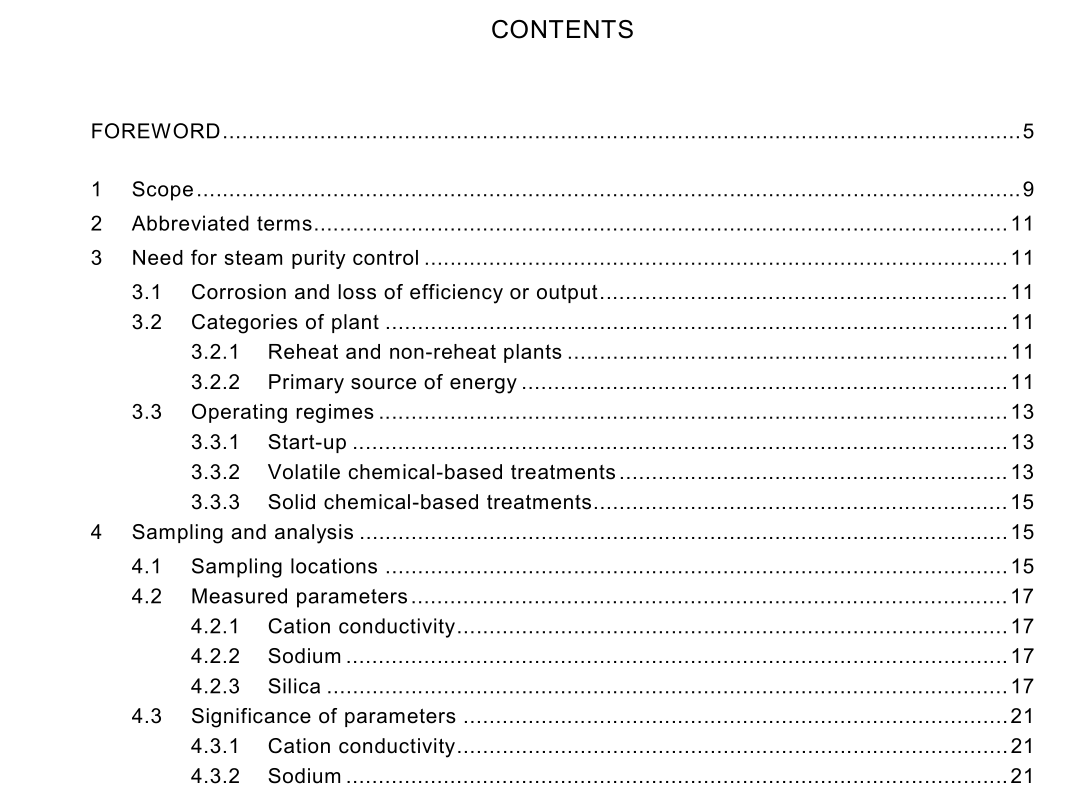IEC TS 61370 pdf download

IEC TS 61370 pdf download.Steam turbines – Steam purity
1 Scope
This technical specification describes the importance of the chemical characteristics of steam supplied to steam turbines and the need to prevent corrosion and deposition in steam space, in order to minimize the risk of turbine corrosion failures or loss of efficiency or output. The significance of relevant chemical parameters, mostly related to impurity levels, is discussed in terms of types of plant and chemistry operating regimes. This specification is applicable to turbines of all electrical output rating and any exhaust condition,i.e. condensing or back pressure. However, the range of application in terms of output rating or steam pressure is dictated by economic factors such as the relative cost of monitoring equipment and turbine plant. It is designed for new plant, but may be adapted for use on existing plant. The limits described in this specification are specifically designed to protect the steam turbine. The user should also be aware of steam purity requirements imposed by other considerations such as components of the boiler or steam generator. This specification is applicable to steam turbines driven from any source, except geothermal plants in which the turbine is fed direct from the geothermal sources. After the initial start of the turbine it may take some months for best achievable chemistry to be reached. This tends to be achieved sooner for some parameters ( sodium, cation conductivity) than for others (silica, iron, copper). It is therefore recognized that during commissioning, it may be difficult to meet normal targets, but a steady improvement should be observed as the steam cleans up. Annex A provides recommended guidelines for this specification and verification of the chemical purity of steam entering a steam turbine, in order to maintain the integrity and efficiency of the turbine. The limits stated are not intended to be mandatory, but to be used as the basis for local instructions for individual plant. Verification is addressed as the selection of appropriate sampling locations and continuously or intermittently measured parameters.
3 Need for steam purity control
3.1 Corrosion and loss of efficiency or output High purity steam is required to ensure steam turbine operation with a high degree of efficiency,output, and availability. Impurities can form deposits, which can lead to loss of efficiency or output or to corrosion. Corrosion can potentially lead to total failure of rotating components. Conditions in expanding steam are such that even a low concentration of an impurity can coexist with a small quantity at high concentration in moisture over a narrow range of temperature and pressure conditions, which may coincide with the surface of a turbine component. It is therefore desirable to minimize the content of impurities. The levels recommended in this specification are established as achievable, measurable and consistent with a high level of efficiency, output and availability. 3.2 Categories of plant 3.2.1 Reheat and non-reheat plants The live steam limits are applicable to machines both with and without reheat. However, the different implications for impurities in these two types of plant should be appreciated. In non-reheat fossil-fuel-fired machines, the temperature of the first condensation within the low-pressure (LP) stages tends to be at a higher temperature than in units with reheat. Thus,the associated risk of corrosion tends to be higher. In units with reheat, there is a tendency for some species to deposit in the reheater and for a slightly better standard of purity to be expected in hot reheat steam than in live steam. 3.2.2 Primary source of energy Tables A.1 to A.3 do not distinguish between primary sources of energy, i.e. whether fossil- fuel-fired or nuclear. However, PWR and BWR plants differ in that steam enters the turbine in saturated condition. Also, some BWR systems operate under an enforced oxygenated neutral condition similar to the OT option for feedwater treatment.









